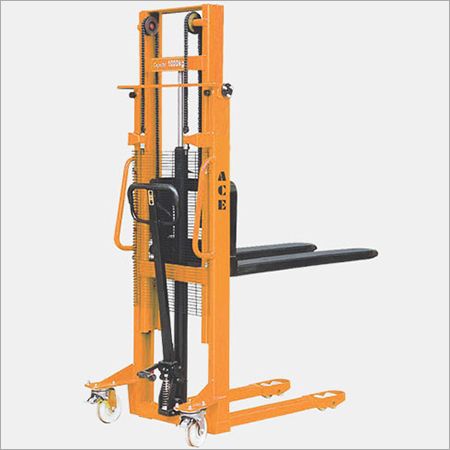Manual Stacker: An Efficient and Cost-Effective Material Handling Equipment

A manual stacker is one of the most efficient, productive, and cost-saving material-handling equipment across various industries. Manual stackers facilitate the lifting, moving, or transportation of palletized loads, products, machines, or any other heavy load within the facility. Most commonly manual stackers are hired in warehouses, large distribution centers, manufacturing facilities, retail stores, etc. The ability to function without electricity makes manual stackers an ideal material handling solution for all sorts of industrial, commercial, and retail spaces.
What is a Manual Stacker?
A manual stacker is a manually operated material handling equipment designed for lifting, moving, and stacking pallets and other heavy loads. It functions without electricity, relying on hydraulic systems and manual effort to operate. Ideal for small to medium-sized operations, manual stackers are used in warehouses, factories, and retail settings where cost-effective and efficient load handling is needed. They enhance productivity by providing an easy-to-use, budget-friendly solution for lifting tasks in areas with limited power access.
Applications of Manual Stacker
Warehouses and Distribution Centers
Manual stackers are most commonly hired in warehouses and large distribution centers, for facilitating the movement of loads across the facility. This helps workers conveniently organize inventory and stack goods on shelves. Commonly they move palletized loads that are easy to maneuver in narrow aisles and confined spaces.
Manufacturing and Assembly Lines
Unlike electric pallet stackers, manual stackers play a vital role in manufacturing facilities to transport products, ingredients, raw materials, machinery, and equipment across assembly lines or different stations. Reducing the manual labor, these material handling tools facilitate higher performance.
Retail and Small Business Operations
Manual stackers move materials or heavy loads from storage areas to workstations or sales floors and help retail and small business operations streamline inventory management and stocking. Moreover, outside the facilities, rough terrain stackers facilitate the loading and unloading of goods and sorts of heavy loads from or to the vehicles.
Loading and Unloading Trucks
Manual Stackers are a big help when it comes to loading or unloading goods from vehicles like trucks. They ensure the safe and secure transfer of materials very swiftly from vehicles to storage units.
Cold Storage and Refrigerated Warehouses
High-quality manual stackers are designed for rough usage, harsh environments, and under extreme temperatures without downtime. These stackers serve cold storage and refrigerated warehouses efficiently to facilitate the movement of heavy loads.
Construction Sites
Manual Stackers assist at construction sites with the movement of materials including cement bags, metal pipes, etc. Rough terrain stackers help construction workers to transport these materials between construction sites.
Agricultural and Farming Operations
Manual stackers also help farmers move heavy agricultural products within the farm, from vehicles to storage areas and vice versa. They also carry equipment and suppliers with efficiency during farming operations.
Automotive Workshops
Automotive workshops extensively hire manual stackers and reel stackers for handling, lifting, and moving vehicle parts across the facility to various stations. To facilitate the transportation of various heavy equipment across assembly lines, these stackers are used on a large scale in automotive manufacturing facilities.
Hospitals and Medical Facilities
Hospitals and medical facilities are often built having confined spaces, where manual stackers are conveniently maneuvered to move medical suppliers, equipment, records, etc., across departments, improving overall productivity levels.
Key Advantages of Manual Stackers
Cost-Effectiveness
Manual stackers are generally more affordable than powered alternatives, making them an economical choice for small to medium-sized businesses. They have lower upfront costs and minimal operating expenses.
Low Maintenance
With fewer moving parts and no reliance on electricity or batteries, manual stackers require less maintenance, reducing downtime and repair costs.
Ease of Use
Designed for straightforward operation, manual stackers are user-friendly and do not require extensive training. Their simple hydraulic mechanism allows operators to lift and move loads with minimal effort.
Versatility
Manual stackers are suitable for a variety of environments, including warehouses, manufacturing plants, retail stores, and more. They can handle different types of loads and fit into tight spaces where larger equipment cannot operate.
Enhanced Safety
Equipped with safety features such as brakes and stabilizing mechanisms, manual stackers help prevent accidents and injuries during operation. Their controlled lifting and lowering reduce the risk of mishandling loads.
Environmental Friendliness
Without the need for electricity or fuel, manual stackers have a lower environmental impact. They produce no emissions and contribute to a greener, more sustainable operation.
Mobility and Flexibility
Unlike battery operated stackers, manual stackers are often lighter and more compact than powered models, making them easier to maneuver in confined spaces. Their portability allows for easy relocation within different areas of a facility.
Increased Productivity
By facilitating the efficient movement and stacking of goods, manual stackers enhance workflow and productivity. They help reduce manual labor, enabling workers to handle loads more efficiently and with less physical strain.
Why Manual Stackers are Preferred Over Powered Stackers?
Here are the various reasons for which manual stackers are preferred over powered stackers:
Cost-Effectiveness
Manual stackers have lower upfront costs and minimal operating expenses compared to powered stackers, making them a more budget-friendly option for small to medium-sized businesses.
Low Maintenance
With fewer moving parts and no reliance on electricity or batteries, manual stackers require less maintenance, reducing downtime and repair costs.
Ease of Use
Manual stackers are straightforward to operate and do not require extensive training. Their simple hydraulic mechanism allows operators to lift and move loads with minimal effort.
Versatility
Manual stackers can be used in various environments and handle different types of loads. They are suitable for applications where powered equipment may not be practical or necessary.
Enhanced Safety
Equipped with safety features such as brakes and stabilizing mechanisms, manual stackers help prevent accidents and injuries during operation. Their controlled lifting and lowering reduce the risk of mishandling loads.
Environmental Friendliness
Manual stackers produce no emissions and have a lower environmental impact compared to powered stackers, contributing to a greener, more sustainable operation.
Mobility and Flexibility
Manual stackers are often lighter and more compact than powered models, making them easier to maneuver in confined spaces. Their portability allows for easy relocation within different areas of a facility.
Increased Productivity
While powered stackers may offer faster lifting speeds, manual stackers enhance productivity by facilitating efficient movement and stacking of goods. They help reduce manual labor and physical strain on workers, enabling them to handle loads more effectively.
How to Choose a High-Quality Manual Stacker For Yourself?
Determine Your Load Requirements
Identify the maximum weight you need to lift and consider the size and shape of the loads, including their width, length, and height. Manual stackers like bag stackers typically range from 500 kg to 1500 kg.
Lifting Height
Assess the maximum height you need to lift your loads based on your shelving or stacking requirements. Manual stackers can generally lift from 1.6 meters to over 3 meters.
Fork Dimensions
Ensure the fork dimensions are suitable for the pallets or loads you handle, including both length and width. Consider stackers with adjustable forks for handling different pallet sizes.
Maneuverability
Consider the turning radius and ease of maneuvering the stacker in your workspace, especially in tight or narrow aisles.
Type of Manual Stacker
Choose between straddle stackers, suitable for closed pallets and different pallet sizes, fork-over stackers which are designed for open-bottom pallets or skids, and counterbalance stackers, ideal for loads that cannot be lifted with straddle legs.
Ergonomics and Safety Features
Look for ergonomically designed handles for comfort and ease of use, an effective brake system for safety, and stability features like wide base legs to prevent tipping.
Material and Build Quality
Select a stacker made from durable materials, such as high-quality steel construction, that can withstand heavy use.
Maintenance and Serviceability
Consider how easy it is to maintain the stacker, including accessible components and a good warranty.
Cost and Budget
Compare the prices of different models and brands, balancing cost with features and quality to ensure good value for your investment.
Related Blog:


